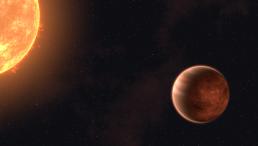There are two faces on Jupiter's moon Europa, one burning brilliantly and the other shrouded in shadow, which is the lunar orb's far hand.
However, new evidence reveals that the ocean underneath the moon's frozen surface on the far side may shine a visible white light with green or blue tints.
NASA's Jet Propulsion Laboratory (JPL) claims the phenomenon is a product of continuous radiation from Jupiter entering the frozen ocean.
The team exploded a combination of ice and salts observed on Europa's surface with Jupiter-like radiation, exposing the 'glows in the shadow' of the moon.
"If Europa weren't under this radiation, it would look the way our moon looks to us -dark on the shadowed side," JPL's Murthy Gudipati, lead author of the study, told CNN.
But because of the radiation from where Jupiter bombards it, Gudipati said the moon glows in the dark.
Habitable Environment?
These findings could also enable scientists to evaluate the chemical composition of the sub-surface ocean of the moon, such as its salinity, which Gudipati said would be "critical for future habitability."
According to evidence from NASA's Galileo Project in the 1990s, the interior of Europa may be composed of oceans of liquid water separating the rocky heart of the moon and the outer ice layer, Murthy said.
"Imagine a full coconut with its hard shell on the outside and then coconut meat (which is close to the ice shell of Europa) and then coconut water on the inside," he said through email.
To divide the light into wavelengths and link the distinct 'signatures' to various ice compositions, Gudipati and his team used a spectrometer.
Most measurements have been made on the moon's day-side using reflecting sunlight, but these recent findings illuminate what the far side of Europa will be like in the evening.
Gudipati and the team saw that this night-side ice glow would support more knowledge on Europa's surface structure.
How the composition differs may send us clues as to whether Europa harbors life-appropriate conditions.' Europa is host to a huge ocean, and scientists expect to figure out whether life is hiding in the large body of water by analyzing the soil.
Shining Light
The team mixed ice with several different salts that were observed on Europa for this research, such as magnesium sulfate and sodium chloride, and blasted the Jupiter-like radiation mixtures, all of which created a glowing result.
Bryana Henderson of JPL, who co-authored the study, said the glow seemed different as they tried new ice compositions. And for a moment, she said they just stared wondered about the unusual glow. "So we pointed at it with a spectrometer, and each ice form had a different range," she said.
In JPL's Ice Chamber for Europe's High-Energy Electron and Radiation Atmosphere Research (ICE-HEART), the mockup of Europa's surface was planned.
And even though the team had wanted to see the light, they were shocked that the form of glow differed in multiple variations, dubbed 'serendipity' by the researchers.
Fred Bateman, the co-author of the study, said the 'aha' moment that altered the direction of the study saw the sodium chloride brine with a slightly lower degree of glow."
In the mid-2020s, NASA is expected to begin the Europa Clipper mission, which will capture data from the moon's surface during a series of flybys while circling Jupiter.
Although this role is not intended to scan for life, it will assess Europa to see if it is worthy of hosting life.
ALSO READ: NASAs Voyager 2 Probe Gets First Command from JPL Since March
Check out more news and information on Space on Science Times.














